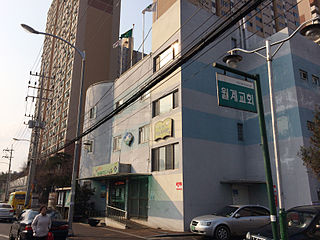Related Research Articles

Wolgye-dong is a dong, neighbourhood of Nowon-gu in Seoul, South Korea.
Sogyeok-dong is a dong, neighbourhood of Jongno-gu in Seoul, South Korea. It is a legal dong administered under its administrative dong, Samcheong-dong.
Jae-dong is a dong, neighbourhood of Jongno-gu in Seoul, South Korea. It is a legal dong administered under its administrative dong, Gahoe-dong.
Wonseo-dong is a dong, neighbourhood of Jongno-gu in Seoul, South Korea. It is a legal dong administered under its administrative dong, Gahoe-dong.
Singyo-dong is a dong, neighbourhood of Jongno-gu in Seoul, South Korea. It is a legal dong administered under its administrative dong, Cheongun-dong.
Nuha-dong is a dong, neighbourhood of Jongno-gu in Seoul, South Korea. It is a legal dong administered under its administrative dong, Hyoja-dong.
Sajik-dong is a dong, or neighbourhood, of Jongno-gu in Seoul, South Korea.
Sinmunno 1-ga is a dong, neighbourhood of Jongno-gu in Seoul, South Korea. It is a legal dong administered under its administrative dong, Sajik-dong.
Sinmunno 2-ga is a dong, neighbourhood of Jongno-gu in Seoul, South Korea. It is a legal dong administered under its administrative dong, Sajik-dong.
Tongui-dong is a dong, neighbourhood of Jongno-gu in Seoul, South Korea. It is a legal dong administered under its administrative dong, Sajik-dong.
Naeja-dong is a dong, neighbourhood of Jongno-gu in Seoul, South Korea. It is a legal dong administered under its administrative dong, Sajik-dong.
Pirun-dong is a dong, neighbourhood of Jongno-gu in Seoul, South Korea. It is a legal dong administered under its administrative dong, Sajik-dong.
Sinyeong-dong is a dong, neighbourhood of Jongno-gu in Seoul, South Korea. It is a legal dong administered under its administrative dong, Buam-dong.
Sagan-dong is a dong, neighbourhood of Jongno-gu in Seoul, South Korea. It is a legal dong administered under its administrative dong, Samcheong-dong.
Songhyeon-dong is a dong, neighbourhood of Jongno-gu in Seoul, South Korea. It is a legal dong administered under its administrative dong, Samcheong-dong.
Pyeong-dong is a dong, neighbourhood of Jongno-gu in Seoul, South Korea. It is a legal dong administered under its administrative dong, Gyonam-dong.
Yeongeon-dong is a dong, neighbourhood of Jongno-gu in Seoul, South Korea. It is a legal dong administered under its administrative dong, Ihwa-dong.

Gongneung-dong is a dong (neighborhood) of Nowon District, Seoul, South Korea.

Hagye-dong is a dong (neighborhood) of Nowon District, Seoul, South Korea.

Junggye-dong is a dong, neighbourhood of Nowon-gu in Seoul, South Korea.
References
- 1 2 "상계동 (Sanggye-dong 上溪洞)" (in Korean). Doosan Encyclopedia . Retrieved 2008-04-26.
- ↑ "Origins: Dong Name Origins" (in Korean). Nowon-gu official site. Archived from the original on 2011-07-21. Retrieved 2008-04-26.
- 1 2 Kim, Hyung-Hook (1998). "South Korea: Experiences of eviction in Seoul". In Azuela, Antonio; Ortiz, Enrique; Duhau, Emilio (eds.). Evictions and the right to housing: Experience from Canada, Chile, the Dominican Republic, South Africa, and South Korea. Ottawa, Ontario: International Development Research Centre. ISBN 0-88936-861-9.
